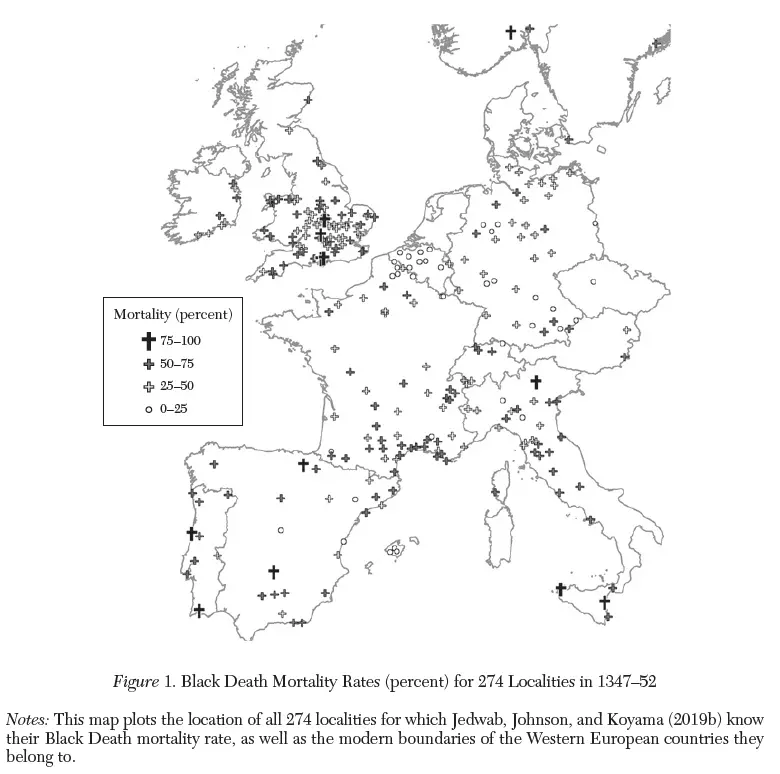Comments
- No comments found

“In October 1347 ships arrived in the Sicilian port of Messina carrying Genoese merchants from the Crimean Port of Kaffa.
In addition to their cargoes, they carried a deadly new disease. Over the next five years, what would come to be known as the Black Death spread across Europe and the Middle East killing between 30 percent and 50 percent of the population …”
This is the opening of a review essay by Remi Jedwab, Noel D. Johnson, and Mark Koyama about “The Economic Impact of the Black Death'' (Journal of Economic Literature, 2022, 60:1, 132-78, need library or personal subscription to access). Of course, public health data for the late 1300s is on the sketchy side. But to give a sense of how this research is done, here’s a map showing 274 locations with data about mortality rates during the Black Death.

With this data, one can extrapolate the likely patterns of Black Death across Europe. With the added dimension of time, one can then look at places where Black Death arrived sooner or later, and where its effect was relatively mild or awful.
For an economist, prone to looking at outcomes in markets, perhaps the most obvious prediction is that in the short run, the Black Death should lead to severe disruptions of agriculture and trade that reduce wages for most people A more subtle shift was that with widespread shortages and those who lived being relatively flush with money, inflation rose. A number of European countries reacted to higher inflation by enacting laws against wage increases.
In England, the Statute of Laborers was passed in 1349 and imposed strict limitations on nominal wages. These restrictions were highly effective in limiting nominal wage growth during the 1350s, though of declining effectiveness thereafter. In France, a comparable statute was passed in 1351 regulating wages, prices, and guild admittances. Similar restrictions were imposed elsewhere in Europe (Heckscher 1955). In Florence, wages were permitted to rise for urban workers, but not for rural laborers who saw their real wages
fall as they had to purchase basic commodities at “hyper-inflated prices” (Cohn 2007a, p. 468). Individuals who left their farms to seek new work were fined.
In the middle run of several decades, however, after economies had a chance to adjust to the worst of the disruptions from the Black Death, the reduction in population meant a reduced supply of workers. More rural workers emigrated to the cities, which had space and jobs. Ther was more land per agricultural worker. All of this led to substantial growth in real wages and income by around 1400.
In addition, the combination of higher wages for workers and deaths among the nobility had a leveling effect on the distribution of income. One quirky consequence was that as more average people were able to afford colorful and distinctive clothing, countries began to pass “sumptuary laws,” which only the nobility were allowed to wear silk, or gold buttons, or certain colors, or to serve two meat courses at dinner. The authors write:
Finally, one institutional response to these leveling effects were sumptuary laws—laws restricting dress based on social status. These began to emerge in Europe in the thirteenth century. However, following the Black Death, they proliferated across Europe. This can be understood as a response to the increased spending power of workers following the plague. Arguing that sumptuary laws were an indication of economic leveling, Scheidel (2017, 206) contrasts an English sumptuary law from 1337 that restricted fur to the nobility to one post- plague that was a response to “growing mass affluence and eroding status barriers.” For example, legislation in England in 1363 notes that the lower orders were now dressing in finer and more colorful clothes. Desierto and Koyama (2020) examine this systematically using newly collected data on sumptuary legislation and a formal model. Their model rationalizes sumptuary legislation as an attempt by elites to repress status competition from
below.
There are many other indirect effects of the Black Death in the longer term. The authors write:
{T]he impact of the Black Death interacted with institutional and cultural developments. Several important institutional developments stand out: (i) serfdom went into decline in western Europe as a direct consequence of the demographic crisis inaugurated by the Black Death (Bailey 2014) and this had important long- run consequences (Gingerich and Vogler 2021); (ii) the regime of high age at first marriage and constrained fertility was strengthened (De Moor and van Zanden 2010, Voigtländer and Voth 2013a); (iii) stronger, more cohesive, territorial states emerged in western Europe; and (iv) there was a weakening in the political power of religious organizations. All of these factors have been argued as playing a role in the economic rise of Europe, and specifically northwestern Europe.
One of the puzzles of global economic history is the “Great Divergence,” which is the pattern by which the economies of Europe soon after the Black Death begin to grow substantially faster than the economies of Asia and the Middle East, which had previously been the world leaders. Of course, many factors were at work. But ironically, one contributor seems to have been the disruptions in economic, social, and political patterns caused by the Black Death.
Timothy Taylor is an American economist. He is managing editor of the Journal of Economic Perspectives, a quarterly academic journal produced at Macalester College and published by the American Economic Association. Taylor received his Bachelor of Arts degree from Haverford College and a master's degree in economics from Stanford University. At Stanford, he was winner of the award for excellent teaching in a large class (more than 30 students) given by the Associated Students of Stanford University. At Minnesota, he was named a Distinguished Lecturer by the Department of Economics and voted Teacher of the Year by the master's degree students at the Hubert H. Humphrey Institute of Public Affairs. Taylor has been a guest speaker for groups of teachers of high school economics, visiting diplomats from eastern Europe, talk-radio shows, and community groups. From 1989 to 1997, Professor Taylor wrote an economics opinion column for the San Jose Mercury-News. He has published multiple lectures on economics through The Teaching Company. With Rudolph Penner and Isabel Sawhill, he is co-author of Updating America's Social Contract (2000), whose first chapter provided an early radical centrist perspective, "An Agenda for the Radical Middle". Taylor is also the author of The Instant Economist: Everything You Need to Know About How the Economy Works, published by the Penguin Group in 2012. The fourth edition of Taylor's Principles of Economics textbook was published by Textbook Media in 2017.
Leave your comments
Post comment as a guest